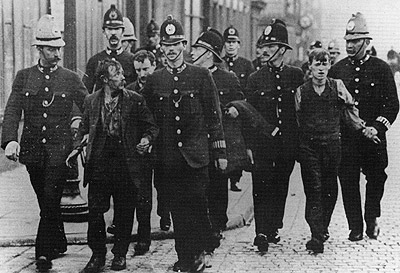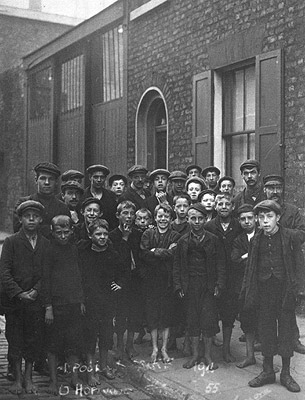
| HOME |
| NERVE |
| REVIEWS |
| ARCHIVE |
| EVENTS |
| LINKS |
| ABOUT US |
| CONTRIBUTORS |
| BACK ISSUES |
| CONTACT US |
Back to index of Nerve 16 - Summer 2010
When Liverpool seamen walked out on 14 June 1911 they took the widespread militancy of the time to a new level. The great Liverpool Transport Strike, involving seamen, carters, dockers and railway workers, proved to be a turning-point in industrial relations, where solidarity and belonging to a union "became part of the fabric of life".
 Near
to Revolution
Near
to Revolution
The strike was arguably the finest hour of Liverpool's labour history. It brought massive rallies, control of the local economy, a gunboat on the Mersey and unprecedented solidarity among workers.
For three months (June to August) the city was virtually at a standstill. Thousands of workers fought their own battles and supported fellow-workers in other disputes. The state's brutality on St George's Plateau on 13 August sparked a brief city-wide general strike.
Society was in ferment in other ways too. Votes for women, Home Rule for Ireland and abolishing the House of Lords were just some of the other issues on the political agenda. In Liverpool, artists like Albert Lipczinski, Charles Reilly, and Augustus John moved alongside Francisco Ferrer (founder of Free Schools) and inspirational workers leader Tom Mann in places such as the International Club, The Clarion Cafe, and the Sandon Club.
2011 will be the centenary of this milestone of struggle. We propose to produce a special calendar documenting the news as it happened and using some of the outstanding images of the time.
We need your help
If you can contribute any material or story from the time, or if you're an artist inspired by these events, we want to hear from you. Just contact the Nerve office at 0151-709 9948 or email: mail@catalystmedia.org.uk
Timeline
 17th
March 1911 - Liverpool Courier reports that black firemen on Elder
Dempster ships have gone on strike as pay is roughly half that of white
firemen.
17th
March 1911 - Liverpool Courier reports that black firemen on Elder
Dempster ships have gone on strike as pay is roughly half that of white
firemen.
10th May - Trades Council supports Womens Suffrage Bill.
12th July - Trades Council Meetings addressed by Tom Mann who calls for support for transport strike.
13th August - Bloody Sunday - Police attack 80,000 strong demonstration outside St George’s Hall
14th August - The Times states, "Anarchy reigns in the city".
15th August - Five prison vans attacked on the way to Walton under military escort, 2 men (Michael Prendergast and John Sutcliffe) are shot dead.
17th August - HMS Antrim moves into the Mersey. HMS Warrior to Douglas, Isle of Man.
20th August - Funerals of Michael Prendergast & John Sutcliffe. 300 protestants & catholics attend funeral at (Catholic) Ford cemetery.
1st September - Times reports verdicts of 'justifible homicide' in inquests of Prendergast & Sutcliffe.
4th November - Daily Post reports that the National Union of Dock Labourers (NUDL) Liverpool membership rose from 7,000 to 31,000 this year.
Comments:
Comment left by george on 9th March, 2011 at 1:41
I am a pendergast descendant,liverpool born,and 1911 was my Mothers year of birth in Waterford ireland.So Iam very interested in details of Michael Prendergast's death.What can you provide as regards family,district etc?
Comment left by Joan Dwyer on 2nd February, 2016 at 21:11
I am the great niece of John Sutcliffe. My family knew John had been shot in August 1911. We were told it was an accident which happened when he came outside to close his window shutters. He lived in the house shown in you illustration. I found out a couple of years ago ,through professor Sam Davies of JMU university, that ,in fact ,he was unarmed, not rioting and was shot twice through the head by a soldier a few feet from his own front door. He was due to be married 3 weeks later. I am very angry that he was branded a rioter in the history books and disgusted that he was unlawfully murdered by our government. No one answered for his killing or the other innocent man killed. Winston Churchill was Secretary of State at the time and I truly believe that this young man deserves an impartial inquest and the murder should be investigated by the police even though it was more than 100yrs ago. Justice was not served at the time.